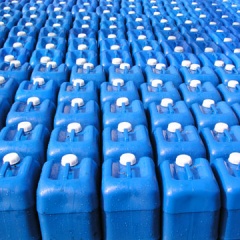Phosphoric acid
| Infobox on Phosphoric acid | |
|---|---|
| Example of Phosphoric acid |  |
| Facts | |
| Origin | - |
| Stowage factor (in m3/t) | 1,77 m3m/t (drums) |
| Humidity / moisture | - |
| Ventilation | - |
| Risk factors | See text |
Phosphoric acid
Description
Phosphoric acid is a mineral (inorganic) acid having the chemical formula H3PO4. Orthophosphoric acid molecules can combine with themselves to form a variety of compounds which are also referred to as phosphoric acids, but in a more general way. The term phosphoric acid can also refer to a chemical or reagent consisting of phosphoric acids, such as pyrophosphoric acid or triphosphoric acid, but usually orthophosphoric acid.
Phosphoric acid is a colourless, odourless, sparkling liquid or transparent, crystalline solid, depending on concentration and temperature. Phosphoric acid is produced by oxidizing red phosphorus with nitric acid or white phosphorus under the surface of water with bromine or iodine. It is also obtained by decomposing a mineral phosphate with sulphuric acid.
Application
Phosphoric acid has a wide variety of uses, probably the most important of which is its use as a reactant with ground rock phosphate to produce high-grade superphosphate, a much-used fertilizer. Phosphoric acid is also used as an intermediate for the production of various phosphates which in turn are used for rust proofing, in the manufacture of foodstuffs, for water-softening, synthetic detergents, emulsion paints, fireproof materials and pharmaceuticals.
In addition to being a chemical reagent, phosphoric acid has a wide variety of uses, including as a rust inhibitor, food additive, dental and orthop(a)edic etchant, electrolyte, flux, dispersing agent, industrial etchant, fertilizer feedstock, and component of home cleaning products.
Shipment / Storage
The carriage of phosphoric acid is a growing business and is arousing considerable interest. Wet process acid generally contains appreciable amounts of fluoride and chloride ions which greatly increase its corrosivity. The fluoride tends to increase corrosion in the vapour space while the main effect of the chloride is to increase the possibility of pitting under deposits on the bottom. In the wet process of making phosphoric acid, calcium sulphate is formed and, although mainly removed by filtration, with prolonged storage settling out of further scale occurs. To offset this a system of agitation is incorporated in the containment system to keep the calcium sulphate in suspension. Stainless steel types 316L and 317L have been found to be most effective tank materials for the handling of commercial acid. Some vessels have incorporated both types with 317L being used in the vapour space and the tank bottom and 316L for the remainder.
A number of incidents of phosphoric acid damage to stainless steel ship’s tanks have been observed. Typical phosphoric acid damage is manifest as general steel wastage and/or elephant skin. Phosphoric acid is a crude product and therefore the varieties are legion. Generally, stainless steel tanks found in chemical tankers are resistant to phosphoric acid attack; however, excessive fluoride within the phosphoric acid can initiate corrosion attacks allowing for continuation of the attack by the phosphoric acid itself. Excessive fluoride in phosphoric acid is usually inhibited by the presence of iron and aluminium and therefore it is only in those cargoes which have insufficient iron and aluminium that the fluoride-initiated attack will take place. Recently, however, more incidents of ship’s tank damage have been observed with high levels of iron and aluminium which are clearly not fluoride-initiated attacks, but have been caused by some other element. Further research has lead to the belief that chlorides (600-800ppm) initiated the corrosion. Although chloride corrosion attacks are typically in the form of pitting, it has come to light that that if chlorides initiate the corrosion, phosphoric acid will then continue to attack so that the resulting damage is in the form of general steel wastage and/or elephant skin.
Note: For overseas carriage aspects of Chemicals, the readers are recommended to acquire or have access to a good chemical dictionary, and a copy of the International Maritime Dangerous Goods (IMDG) Code, issued by the International Maritime Organisation. Also consult the applicable MSDS sheet.
Risk factors
Toxic by ingestion and inhalation, irritant to skin and eyes. TLV: 1 mg/m3 of air. Reacts violently with water to evolve heat; dangerous fire risk, keep tightly sealed or stoppered.











